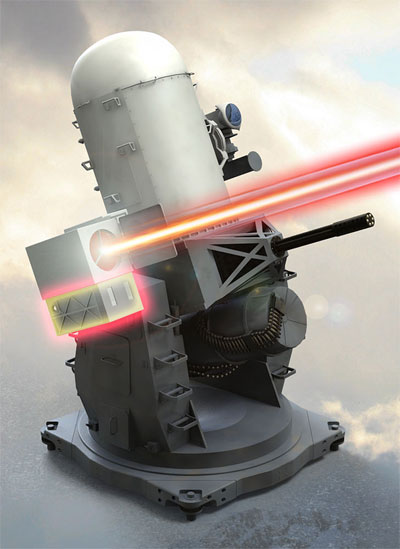William Pentland Contributor
http://www.forbes.com/
The top brass in the U.S. Air Force wants to put laser weapons on ground-attack aircraft.
Speaking at a conference in Washington D.C. on Tuesday, Lt. Gen. Bradley Heithold, the head of the U.S. Air Force Special Operations Command, said he wanted to explore the possibility of outfitting an AC-130 Ghostrider aircraft with laser weapons.
What he didn’t say was whether the airborne laser would be powered by chemical or electric energy?
The Ghostrider is a heavily armed ground-attack aircraft manufactured by Lockheed Martin. The gunship is designed so that weapons are fired from a single side. By circling stationary targets, the aircraft can sustain persistent fire for an extended period of time.

Here is how Tyler Rogoway at Foxtrot Alpha described the AC-130:
The AC-130 flying gunship fleet is one of the most fabled and feared assets in the entire USAF inventory. Known for its ability to unleash a broadside of cannon fire in the dead of night, the newest of the AC-130 lot is more about smart bombs than raining lead and howitzer shells down on the enemy.The Air Force spent about $4.3 billion pursuing airborne lasers that could destroy ballistic missiles between 1994 and 2007, according to the Congressional Research Service. In particular, the Air Force focused primarily on chemical oxygen iodine laser (COIL) systems, which could be mounted in the aft section of a modified Boeing 747 aircraft. Northrop Grumman was the key company leading the COIL effort.
In 2009, former Defense Secretary Robert Gates killed the Air Force’s airborne laser program as part of an effort to reduce spending and reform the military’s acquisition process.
Unlike the chemically-powered lasers pursued by the Air Force, the U.S. Navy has focused on electrically powered lasers. The latter have proven to be far more successful than the former. In December, the Navy completed the first successful deployment of an electrically-powered laser weapon system aboard the USS Ponce in the Persian Gulf.
http://nextbigfuture.com/
January 10, 2015
Israel Iron Beam will become the world's first active duty combat laser in 2015
Iron Beam is an air defense system currently in development by Israeli defense contractor Rafael Advanced Defense Systems.
It is expected to enter service with the Israel Defense Forces in 2015,
the system is designed to destroy short-range rockets, artillery, and
mortars too small for the Iron Dome system to intercept effectively.
This will be the first combat laser fielded for active service. Israel has the pressing need for short range defense that are too close for the Iron Dome. The US has the luxury of taking time to test lasers on navy ships, trucks and fighter planes and then fielding in a few years. Israel has testing in live combat since if the Iron beam fails the mortar would have got through anyway. Patriot anti-missile systems were also rushed into active service in early days of the Iraq conflict.
Iron Beam will use a "directed high energy laser beam" to destroy hostile targets with ranges of up to 7 kilometres (4.3 miles)
Iron Beam uses a fiber optic laser to destroy an airborne target within 4-5 seconds of firing. Whether acting as a stand-alone system or with external cueing as part of an air-defense system, a threat is detected by a surveillance system and tracked by vehicle platforms in order to engage. The main benefits of using a directed energy weapon over conventional missile interceptors are lower costs per shot, an unlimited magazine, lower operational costs, and less manpower.
Rafael Advanced Defense Systems has a page on their high energy laser.
Iron Beam will constitute the fifth element of Israel's integrated air defense system:
* Arrow 2
* Arrow 3
* David's Sling
* Iron Dome.
* Iron Beam
However, Iron Beam is also a stand-alone system
SOURCES - wikipedia, Rafael, Youtube, Mirror UK
This will be the first combat laser fielded for active service. Israel has the pressing need for short range defense that are too close for the Iron Dome. The US has the luxury of taking time to test lasers on navy ships, trucks and fighter planes and then fielding in a few years. Israel has testing in live combat since if the Iron beam fails the mortar would have got through anyway. Patriot anti-missile systems were also rushed into active service in early days of the Iraq conflict.
Iron Beam will use a "directed high energy laser beam" to destroy hostile targets with ranges of up to 7 kilometres (4.3 miles)
Iron Beam uses a fiber optic laser to destroy an airborne target within 4-5 seconds of firing. Whether acting as a stand-alone system or with external cueing as part of an air-defense system, a threat is detected by a surveillance system and tracked by vehicle platforms in order to engage. The main benefits of using a directed energy weapon over conventional missile interceptors are lower costs per shot, an unlimited magazine, lower operational costs, and less manpower.
Rafael Advanced Defense Systems has a page on their high energy laser.
Iron Beam will constitute the fifth element of Israel's integrated air defense system:
* Arrow 2
* Arrow 3
* David's Sling
* Iron Dome.
* Iron Beam
However, Iron Beam is also a stand-alone system
SOURCES - wikipedia, Rafael, Youtube, Mirror UK

US Navy to test powerful, mobile laser weapon against drones
A compact yet powerful laser weapon developed by Raytheon will soon be
integrated on a HMMWV, to demonstrate its ability to defeat enemy
drones, as part of the enhancement of current US Marine Corps
ground-based air-defense capabilities.
The US Navy Office of Naval Research has awarded Raytheon US$11 million adapt a tactical laser weapon
systems to a vehicle-based laser device, capable of defeating
low-flying threats such as enemy drones. For the field demonstration
planned by ONR Raytheon will integrate a short-range laser weapon system on a HMMWV. When systems are fielded they are likely to deploy on the future Joint Light Tactical Vehicle (JLTV). Some of the system’s components have already been tested under the ‘Ground Based Air Defense (GBAD)
Directed Energy On-the-Move Future Naval Capabilities’ program,
demonstrating detection and fire control functions of the system, with
the compact phased array radar detecting and tracking UAVs of all sizes.
Later in the year, researchers will test the entire system against
targets using a 10kW laser as a stepping stone to a 30kW laser. Raytheon will deliver a laser with a minimum power output of 25kW will be used. According to ONR,
the 30kW system is expected to be ready for field testing in 2016.
Tests will evaluate the complete intercept process, from detection and
tracking to firing, all battle-damage assessment, all based on sensors
and effectors integrated on the test vehicle.

Raytheon’s
laser architecture is implemented in a number of directed-energy weapon
applications, including the Laser-Phalanx derivative of the classic
naval Close-In Weapon System. Illustration: Raytheon.
Raytheon’s laser solution generates high power output in a small, light-weight rugged package ideally suited for mobile platforms,” said Bill Hart, vice president of Raytheon Space Systems. Raytheon’s planar waveguide (PWG) technology is the key to its unique approach to high energy lasers. Using a single PWG, the size and shape of a 12 inch ruler, Raytheon high energy lasers generate sufficient power to effectively engage small aircraft. According to Hart, the technology implemented for the test is scalable to more powerful systems. “Our PWG laser architecture is scalable: we can achieve increasingly higher power levels with the same compact design we’re using for GBAD.” he said. With the proliferation of UAVs in the modern battlefield, the Marine Corps expect that units increasingly will have to defend themselves against adversaries trying to perform reconnaissance, surveillance and attack from the air by unmanned systems. According to Col. William Zamagni, head of ONR’s Expeditionary Maneuver Warfare and Combating Terrorism Department, GBAD will give the Marine Corps a capability to counter those UAV threat efficiently, sustainably and organically with austere expeditionary forces. “GBAD employed in a counter UAV role is just the beginning of its use and opens myriad other possibilities for future expeditionary forces.”

According to Raytheon, the patented Planar Wave-Guide architecture enables the implementation of single aperture optical design; without the use of complex optical beam combining elements, delivering high beam quality, and scalability beyond 200 kW output power. The design also features efficient heat removal and thermal management

The Ground Based Air Defense (GBAD) Directed Energy On-the-Move Future Naval Capabilities program calls for a field demonstration of a Humvee-mounted short-range laser weapon system with a minimum power output of 25kW. The Raytheon-built laser will be packaged to meet the U.S. Marine Corps’ demanding size, weight and power requirements. Illustration: Raytheon
http://uk.businessinsider.com
Here's How The World's Most Advanced Missile-Defense System Works

via Lockheed Martin
The most advanced missile system on the planet can hunt and blast incoming missiles right out of the sky with a 100% success rate — from a truck. With its unmatched precision, the Terminal High Altitude Area Defense (THAAD) can equalize tensions around the world with its mobility and strategic battery-unit placement: In April 2013, the Pentagon deployed a THAAD battery to Guam in order to deter North Korean provocations and further defend the Pacific region.
Impressively, the THAAD missile does not carry a warhead, instead using pure kinetic energy to deliver "hit-to-kill" lethality to ballistic missiles inside or outside of the atmosphere. Each launcher carries up to eight missiles and can send multiple kill vehicles out, depending on the severity of the threat.
Lockheed's THAAD launcher is one element of this highly integral anti-missile system. This graphic from Raytheon shows the rest of the equipment needed for each enemy-target interception.

via Raytheon
How THAAD works
First, an incoming target missile is first launched from another location. Five minutes later a truck-mounted THAAD interceptor missile launches in pursuit of the target.According to the US Missile Defense Agency, there are more than 6,300 ballistic missiles outside of US, NATO, Russian, and Chinese control, and other US partners around the globe are looking to broker a deal to purchase THAAD.
The United Arab Emirates has become the first foreign buyer after signing a deal with the Department of Defense for $3.4 billion. Saudi Arabia and Qatar have "expressed interest," according to Richard McDaniel, vice president of Patriot Advanced Capability programs at Lockheed Martin. "We expect deals," he added.




No comments:
Post a Comment